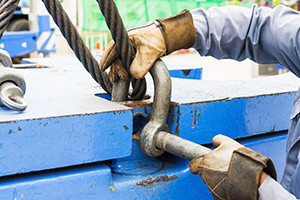 Rigging. It’s a common work practice in construction, but many in general industry also have a need for lifting loads. If done incorrectly, rigging can be incredibly dangerous. Not only can a dropped load cause property damage, but it can lead to a serious injury or fatality should the load hit someone.
Rigging. It’s a common work practice in construction, but many in general industry also have a need for lifting loads. If done incorrectly, rigging can be incredibly dangerous. Not only can a dropped load cause property damage, but it can lead to a serious injury or fatality should the load hit someone.
Knowing how to identify rigging hazards, understanding how to use rigging properly, and ensuring the proper inspection of all rigging is critical for workplace safety.
Too often we encounter workers who don’t fully understand rigging. They put the pieces together, almost as if they are Legos, but they don’t pay attention the forces which could be impacting their lifting device.
Do your workers know how to properly use below the hook lifting devices such as slings, hooks, and shackles? Consider slings. If you overload the sling, it can fail and drop the load. So you need to be able to determine the sling’s working load limit. An important factor in calculating this limit is sling angle tension. Without understand the basic calculations, these invisible forces can put your load, and your workers, in danger.
What about proper inspection and maintenance? Are workers trained to properly inspect the hardware to ensure it is safe to use? Do they know how to maintain and take care of the equipment to keep it in safe working order? It is critical to properly train employees on how to inspect and maintain all rigging equipment.
And when a piece of rigging equipment is ready to be taken out of service, what do you do with it? Do you have documented removal criteria? Say you throw away a synthetic web sling and someone picks it up to use as a tow hitch but it breaks and causes damage or injury. You could be held liable because you did not dispose of it properly. So make sure you are disposing of these devices properly.
Consider these common rigging gear problems. Are they occurring in your workplace? Do your employees have adequate training to identify these hazards and prevent accidents?
- Trained riggers not assigned
- Improper use of hand signals
- Not inspecting rigging properly
- Not knowing what to inspect for
- Missing or illegible tags on slings
- Capacities not known
- Improperly made below the hook devices
- Wire rope slings formed with clips
- Overloading a sling because the center of gravity was not known
- Too small or large of hardware connected to sling eye
- Bunching or pinching of synthetic slings
- Loose shackle pins or connections
- Missing latches
- Placing too many slings on one piece of hardware
- Improper loading of the hardware
- Beating down the choker hitch
- Basket capacities used when not vertical
- Basket hitch (wire rope) over a small diameter
- Capacities of a bridal not adjusted for angle
- Sling loads not properly distributed
- Use of horizontal sling angles < 30 degrees
- Choker and basket hitches at horizontal sling angles < 60 degrees
Training your employees – both new and current – on the proper inspection, maintenance, and use of below the hook lifting devices can help improve workplace safety and prevent accidents.



